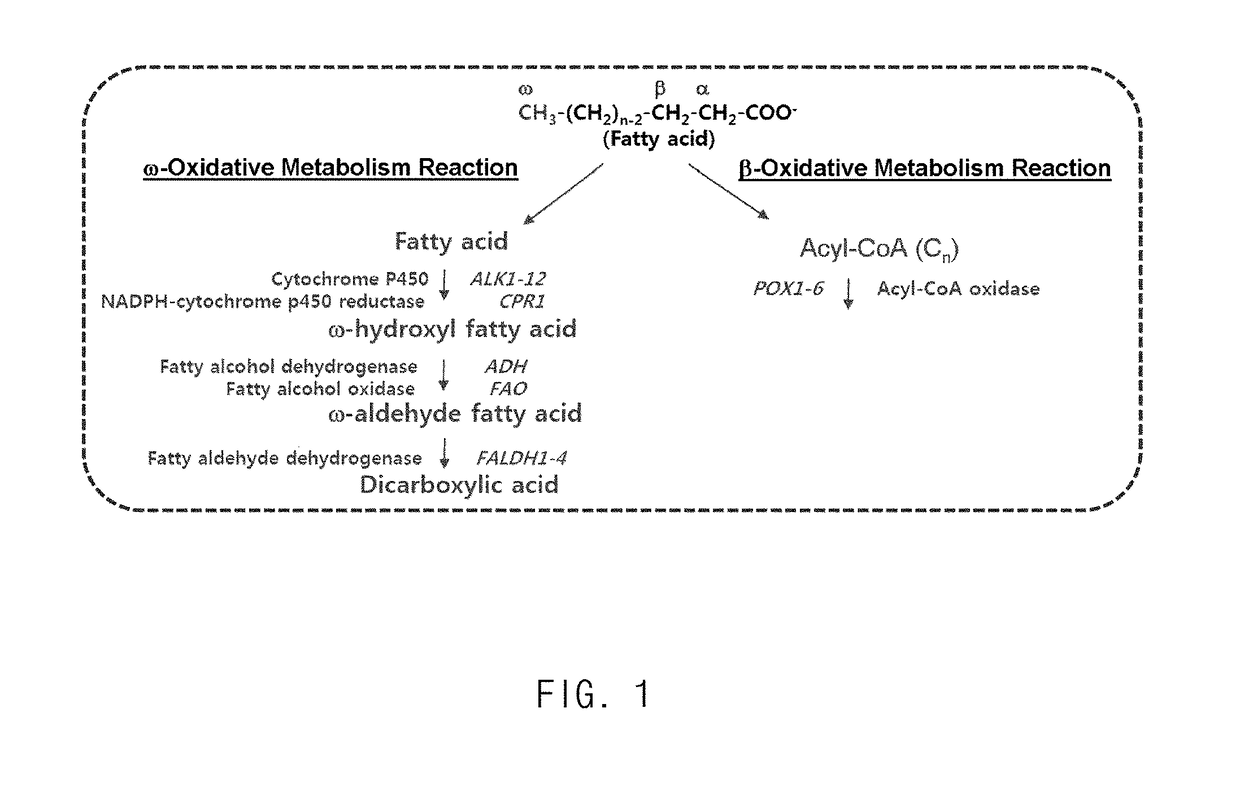Method for producing heavy chain aminocarboxylic acid
a technology of aminocarboxylic acid and medium chain, which is applied in the direction of enzymology, biochemistry apparatus and processes, transferases, etc., can solve the problems of not being able to produce high-quality medium-chain aminocarboxylic acid
- Summary
- Abstract
- Description
- Claims
- Application Information
AI Technical Summary
Benefits of technology
Problems solved by technology
Method used
Image
Examples
example 1
ion of Knock-Out Cassette
[0045]A vector containing an ura3 gene to be used as a selective marker for gene knockout to modify a strain, and a pop-out region for deleting the ura3 gene after insertion of a knock-out cassette was constructed (FIG. 3). A Yarrowia-derived gene was used as the ura3 gene, and the pop-out region used to modify a strain had a total of four sequences, and was referenced from two genes. Here, a Bacillus-derived glutamate-producing gene was used as one of the genes, and a gene associated with a Salmonella- or cloning vector pHUKH-derived His operon was used as the other one. The primers and sequences thereof used to construct the pop-out vectors are listed in the following Table 1.
TABLE 1Pop-out VectorsSEQ IDNamesBase SequencesNOsHisG1BglII Faattgggcccagatctcagaccggttcagacaggat13EcoRI Rtctctgggcggaattcggaggtgcggatatgaggta14NotI FtgTTTCTCGgcggccgccagaccggttcagacaggat15BamHI RTCCAACGCGTGGATCCggaggtgcggatatgaggta16HisG2BglII Faattgggcccagatctaacgctacctcgaccagaaa17...
example 2
ion of Transduction Vector
[0048]To insert an ω-transaminase into a Yarrowia strain, a vector as shown in FIG. 5 was constructed. The primers used for this purpose are listed in Table 4.
TABLE 4Transaminase VectorsSEQ IDNamesBase SequencesNOsEXP 1-FccaagcttggtaccgagctcaGagtttggcgcccgttttttc79EXP1-RCGTTGTTTTTGCATATGTGCTGTAGATATGTCTTGTGTG80TAATEF-Fccaagcttggtaccgagctcaaactttggcaaagaggctgca81TEF-RCGTTGTTTTTGCATATGTTTGAATGATTCTTATACTCAG82AAGALK1-Fccaagcttggtaccgagctcagatctgtgcgcctctacagaccc83ALK1-RCGTTGTTTTTGCATATGagtgcaggagtattctggggagga84XPR2t-F2gtcgacgcaattaacagatagtttgccg85XPR2t-R3ctcgagggatcccggaaaacaaaacacgacag86TA-FCATATGCAAAAACAACGTACTACCTCCC87TA-RgtcgacTTAGGCCAAACCACGGGCTTTC88ATATG2-ER-FactcctgcactCATatgtccaacgccctcaacctg89XTATG2-ER-Fccaatccaacacatatgtccaacgccctcaacctg90ER-R-1CGTTGTTTTTGCATAGAACCGCCACCGCCGCTACCGC91CACCGCCCGAACCGCCACCGCCgaatcgtgaaatatccttgggctER-R-2CGTTGTTTTTGCATatgAGAACCGCCACCGCCGCTACC92GCCACCGCCCGAACCGCCACCGCCgaatcgtgaaatatccttgggctETATG2-ER-1tgattacgccaagcttGag...
example 3
on of Recombinant Microorganism Strain
[0051]The knock-out cassette constructed in Example 1 and the transduction vector constructed in Example 2 were used to prepare a total of eight knock-out strains from which some of all of a fatty aldehyde dehydrogenase gene in an ω-oxidative metabolism pathway present in a wild-type Yarrowia strain and β-oxidative metabolism pathway-related genes were deleted and into which an ω-transaminase gene was also introduced (FIG. 6). Specifically, a strain in which a gene was to be knocked out or be introduced was plated on an YPD plate, and cultured at 30° C. for 16 to 24 hours. The cultured cells were scraped with a loop, put into 100 μL of a one-step buffer (45% PEG4000, 100 mM DTT, 0.1 L of LiAc, 25 μg of single-strand carrier DNA), and vortexed. Thereafter, the knock-out cassette and the transduction vector (1 ng or more) were added thereto, and the resulting mixture was vortexed again, and then cultured at 39° C. for an hour. The cultured sample ...
PUM
| Property | Measurement | Unit |
|---|---|---|
| specific gravity | aaaaa | aaaaa |
| pH | aaaaa | aaaaa |
| volume | aaaaa | aaaaa |
Abstract
Description
Claims
Application Information
 Login to View More
Login to View More - R&D
- Intellectual Property
- Life Sciences
- Materials
- Tech Scout
- Unparalleled Data Quality
- Higher Quality Content
- 60% Fewer Hallucinations
Browse by: Latest US Patents, China's latest patents, Technical Efficacy Thesaurus, Application Domain, Technology Topic, Popular Technical Reports.
© 2025 PatSnap. All rights reserved.Legal|Privacy policy|Modern Slavery Act Transparency Statement|Sitemap|About US| Contact US: help@patsnap.com



